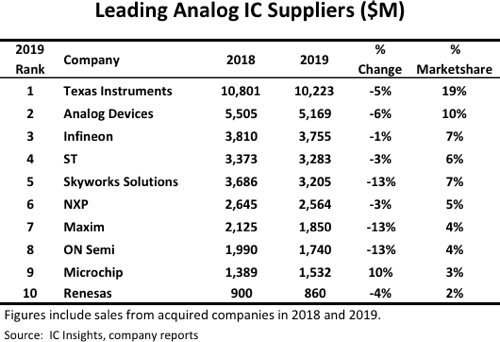Samsung Electronics Co., Ltd., the world leader in advanced memory technology, today announced plans to expand its NAND flash production capacity in Pyeongtaek, Korea, reinforcing the company’s ability to meet demands from emerging technologies. Construction, which began this May, will pave the way for mass production of Samsung’s cutting-edge V-NAND memory in the second half of 2021.
Paper-Thin Gallium Oxide Transistor Handles More Than 8,000 Volts
In a study published in the June edition of IEEE Electron Device Letters, electrical engineers describe how the tiny electronic switch can handle more than 8,000 volts, an impressive feat considering it’s about as thin as a sheet of paper.
Texas Instruments Maintains Firm Grip As World’s Top Analog IC Supplier
TI’s 2019 analog marketshare grew to 19% and ST climbed to fourth place as the top-10 suppliers collectively accounted for 62% of total analog sales.
Synopsys’ Silicon-Proven DesignWare DDR IP for High-Performance Cloud Computing Networking Chips Selected by NVIDIA
Synopsys, Inc. (Nasdaq: SNPS) today announced that its silicon-proven DesignWare® DDR5/4 PHY IP will be used by Mellanox, NVIDIA’s networking business unit, to address evolving memory requirements in its InfiniBand networking chips targeting high-performance computing and artificial intelligence (AI) applications.
CyrusOne Deploys Liquid to Chip Cooling Solution
CyrusOne Inc. (NASDAQ: CONE), a global data center real estate investment trust (REIT), today announced the use of the latest Internet Computer Concepts (ICC) and Asetek technologies for cooling design solutions across campuses.
Kulicke & Soffa Appoints Jeff Richardson to its Board of Directors
Kulicke and Soffa Industries, Inc. today announced the appointment of David Jeffrey Richardson to its Board of Directors.
Huawei Snaps Back at Inspur in the Fourth Quarter, Regaining Server Market Share in China
Huawei’s share of China’s server market revenue surged by 10 percentage points in the fourth quarter of 2019 to reach 25 percent as the vendor closed more than $1.2 billion worth of server sales and cut into the lead of top supplier, Inspur.
Ventev Partners with Cisco for IoT Design Program
Ventev, the manufacturing unit of TESSCO Technologies, Inc. (Nasdaq: TESS), recently announced its selection as a partner in the Cisco Internet of Things Design-In Program. The program offers customers integrated power solutions, featuring Cisco industrial IoT networking and data solution products.
Lattice and Etron Deliver Small, Low Power Reference Design for Edge AI and Video Processing Applications
The reference design reduces power consumption, overall design size, and data latency by allowing developers to store data used in AI and smart vision applications locally instead of using larger, external memory cards.
SEMICON Southeast Asia 2020 Goes Virtual to Highlight Industry Innovation and Growth Opportunities
SEMICON Southeast Asia 2020 is going virtual as the region’s premiere global electronics manufacturing supply chain exposition and conference continues its rich tradition of gathering industry experts from around the world for critical insights into the semiconductor ecosystem, new business opportunities and collaboration. SEMICON SEA 2020 registration is now open.
